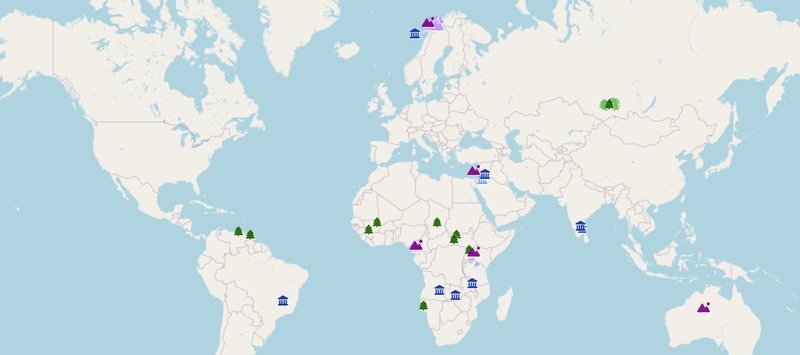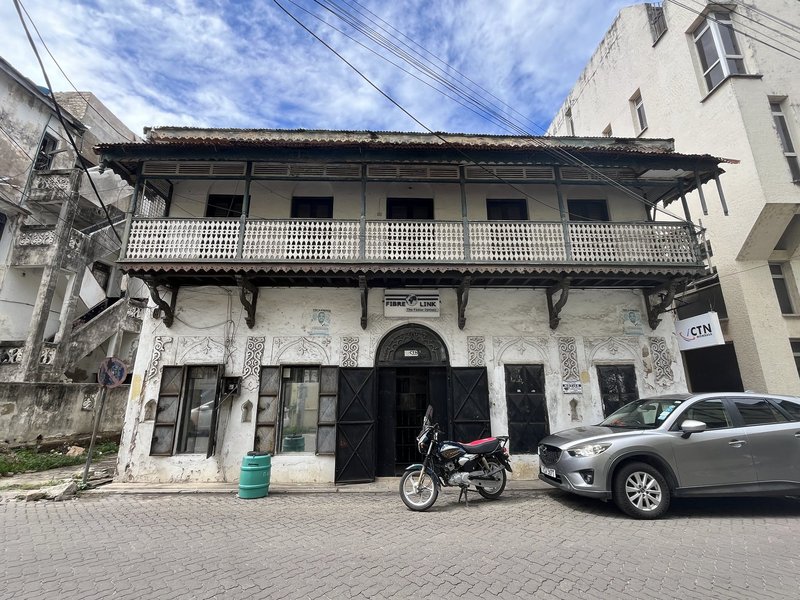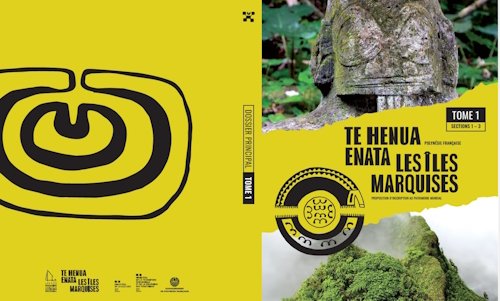WHS with Inselbergs
Connection – August 9, 2025 by Els SlotsInselbergs is a Connection we have had for a long time, and it has 23 entries. They may be so popular because they are literally "outstanding" features in a landscape. Let’s have a closer look at Inselbergs and their position on the World Heritage List.
What is an Inselberg?
An inselberg is created when a body of hard, erosion-resistant rock is left standing after the surrounding softer, less resistant rock has weathered away. This process is called differential weathering.
Where does the name come from?
“Inselberg” literally means “Island mountain”. It is a loan word from German, as it was coined by the German geologist Wilhelm Bornhardt in 1900. They are known as "monadnock" in the US (an indigenous Abenaki term), or "kopje" (Afrikaans) in southern Africa.
Globally?
The 23 connected WHS with Inselbergs show a wide geographic spread:

Still, you won’t find them everywhere:
Europe has very few inselbergs. This is mostly due to the impact of the recent Ice Ages. Vast ice sheets acted like colossal bulldozers. This erased any inselbergs that might have been forming. After the glaciers melted, they buried the landscape with massive deposits of sediments such as sand and gravel, preventing the classic "mountain …
Introducing: Points of Interest
Website – July 30, 2025 by Els SlotsThis weekend, we are introducing a new feature to our maps of WHS: Points of Interest (POIs). These are spots to visit in or near a WHS, based on insider tips aimed at the WH Traveller.
A feature on the WHS maps
These POIs will be added to maps of WHS only, so they are not visible on any other maps on this website.

They will, of course, not replace the formal location(s) of the WHS, as determined by UNESCO or found by us where the info was lacking, the so-called Community Identified Locations. The formal locations can be recognized by their bright colours: a blue monument for a cultural WHS, a green tree for a natural WHS, and a purple mountain for a mixed WHS.
Note: these formal location(s) will in the future be shown as Core Zones, which will demarcate the full inscribed area. This is a long-term project, however, so most WHS locations for the time being will solely be marked as a colourful dot on the map.
The POIs
With the migration, we have already added over 1,000 plaque locations as POIs to our maps of WHS. The plaques are representative of the idea of …
Yemen’s New Tentative List
Country – July 25, 2025 by Els SlotsLast Tuesday, Yemen’s new tentative list was published on the UNESCO website. It contained no less than 31 new entries. This was a remarkable event as (a) we rarely see such large updates, and (b) Yemen is a country at war, with a struggling central government, and all its current WHS, except for the archipelago of Socotra, are In Danger.
The New List in numbers
We could have seen this New List coming, as in December 2024, UNESCO reported on a series of online workshops that were held to revise Yemen’s World Heritage Tentative List.
These workshops resulted in 37 new proposals, of which almost all (31) have now been added to the Tentative List. Four out of nine sites from the old Tentative List also remain active. Four of the new sites were replacements for existing ones (one of those is still double-listed on the UNESCO website). Additionally, two FTWHS were incorporated into the newly listed selection.
The Operational Guidelines for the Implementation of the World Heritage Convention do not put a limit on the number of sites on a State’s Tentative List, but speak of an “important planning tool .. as they provide an indication of future …
Using Artificial Intelligence for World Heritage topics
Website – July 22, 2025 by Els SlotsWhile building the new version of this website, we had a lot of tedious tasks that we gladly wanted to outsource to Artificial Intelligence (AI) tooling like ChatGPT. This was true both for the technical side (Nan plans to do a full reveal there in a future blog) and for the content. For the latter, it was my first time seriously working with AI tooling. This is what I found.
Member since
When you look at the Community Page, you see an option to sort by “Joined”. It will show you the community members in order of when they signed up. This is a new feature.
We only actively started registering the sign-up date in 2017, so we had to gather additional data to give credit to the hundreds of early users who have been with us since around 2005. We used ChatGPT to create a script to crawl through all the old community index pages in the Wayback Machine to see where the first occurrence of a member's name was.
It ended up with a pretty good list – the dates may be off by 3 months or so, but the order is fairly correct. I carefully …
Website launch 2.0 - Update
Website – July 15, 2025 by Els SlotsSo we have been ‘live’ for a week now with the fully refurbished version of this website, survived the WHC 2025 as the ultimate crash test and conducted a global sociological experiment on “dealing with change”.
The reviews are steadily flowing in again. And you do well in adding full-size photos to be used on the website. For the latter, please make clear in the title which site it represents – “icebergs” alone will not do it, and neither does “IMG_008”. Do “Vienna” or “Vienna Coffee House”.
We understand that there is a learning curve to get to know the new website. And, because in this stage there are still bugs here and there, it can be hard to know what it is supposed to do. We will keep on working on fixing these issues and smoothing the effects of some radical choices. For “How to’s” and the status of the main issues/features/plans, read the F.A.Q’s which will be regularly updated:
- FAQ General: logging in, managing your content, generic questions
- FAQ Adding Photos
- FAQ Counting your visits
- FAQ Maps
10 Bits Of Trivia About The WHS Of 2025
WHC – July 15, 2025 by Els SlotsOver the past weekend, we gained 26 new sites on the World Heritage List, and 2 sites were extended. You can find all decisions here, on our fancy new session page. Find below some aspects that warrant a closer look.
A turning point has crossed
Possibly, we have witnessed the final tipping point, where no member dared or wanted to express opposing views against other member states anymore. As Durian stated at the Forum, the WHC lacked a "strong rule keeper". The delegates of Lebanon (he must have been present 20 times already) and India do have the knowledge and experience to be one, but they choose to use their arrows selectively. So Lebanon applauds the UAE and scolds poor Nepal.
Rejection advice overturned
We saw the rare occurrence of a site, that had been advised to Not to be Inscribed by ICOMOS, to be overturned by full consensus to be Inscribed: Faya Palaeolandscape (UAE). This, despite a gentleman’s agreement a few years ago that those would be withdrawn by the State Party before the session. It was accompanied by a nasty rant by Qatar towards ICOMOS, which came down to “you don’t understand anything about our region”.
…
Proudly Presenting V2.0
Website – July 6, 2025 by Els SlotsI am so happy to present to you today the fully refurbished version of this website. A new design, a new back-end, lots of additional pictures and new pieces of content.
Why?
This is already a rather old website; the domain was registered on July 31, 2000. Since then, it has continued to expand, with ever more content created by significantly more members. Today, we have almost 2000 active users, 82000 page views a month, 10808 reviews, and nearly 15,000 images. All the time, the technical back end of the website essentially stayed the same as when it was my private blog: a mostly self-coded website.
We had been working on a new version centered around a true content management system (CMS) on and off for the better part of seven years. It had been clear for a while that CMS features would benefit this site significantly and that many wishes for improvements were not possible in the legacy setup. But COVID, our travels, and the massive amount of data to migrate were insurmountable obstacles.
Then two things happened:
- In 2024, our hosting provider for a decade terminated our contract as we were crashing their servers due to the load. …
Updated Tentative Lists H1 2025
Website – June 29, 2025 by Els SlotsEvery morning around 11 a.m. I do a quick check of this direct link to see whether UNESCO has registered any new Tentative Sites. When they do, I try to add the new records to our website as quickly as possible as well. The people in Paris rarely update before 11 a.m., and afternoon changes only occur when they have a lot to add. The Tentative Sites, for some reason, do not appear in chronological order – sometimes they post things that have been submitted months before. Let’s have a closer look at what the crop of the first half of 2025 brought us.
The Numbers
I have written about the trends in Tentative Sites before, trying to determine The Value of a TWHS . So does the first half of 2025 confirm this pattern?
At the time of writing (June 28, 2025), all Tentative Lists combined add up to 1778 sites. In the first half of 2025, 49 new Tentative Sites were added. 9 of those were 1-on-1 replacements of earlier ones. An additional 15 TWHS were removed and became Former TWHS.
49 new ones in the first half of the year are significantly above average, as are the …
Top Tips for Kenya
Country – June 22, 2025 by Els SlotsKenya almost killed me. The murder attempt actually was done by a Kenyan goat, which, while I was walking the streets of Old Mombasa (pictured below), decided to make a run for its freedom and jumped down to street level from a balcony. Its hoof bruised my hand black and blue, but it could as well have landed on my head. It must have been an absurd scene to watch, but the Kenyans aren’t disturbed by a bit of chaos and unpredictability.
Still want to go? Here are some tips for travelling to Kenya as a WH Traveller.

1. Be flexible
Kenya overall is an easy country to travel in: they’re used to tourists, almost everybody speaks English and is willing to help you out (often hoping there’s a little extra in it for them, but not pushing for it). But it certainly doesn’t run like clockwork: departure times of all my 3 domestic flights and the international flight were changed significantly at least once, access to a site that was granted can be revoked for vague reasons (see my Kaya Kauma story), I had an airport transfer who didn’t know how to get to the airport, etc. So be …
Nomination Dossiers
UNESCO – June 1, 2025 by Els SlotsWhile preparing for my upcoming Kenya trip, I was studying the Arabuko-Sokoke Forest (part of the Coastal Forests of Kenya TWHS ). It turns out that they are looking towards a nomination , but estimate that they would need 100k-300k USD to complete it (and subsequently wondered how they would get access to so much money). The nomination dossiers have also been addressed in the WHC 2025 documents that were published this week, where a change of the format is considered for a myriad of reasons, including "to promote possibly shorter and less costly nomination dossiers".
Maybe it’s time to have a closer look at those Nomination Dossiers (I wrote about Incomplete Dossiers before).

History of the Nomination Dossier
The nomination dossier, as we now know it as an extensive glossy brochure, came into existence in 1998. After the first years of WHS, an overall need to get a grip on several aspects of the nomination process grew. In 1996, a fixed format for nominations was decided upon. That format is mostly still in use, although more specific questions are now being asked about risk preparedness, indigenous peoples, financial resources, etc.
When we look at a few examples of nomination …